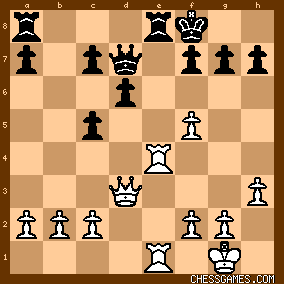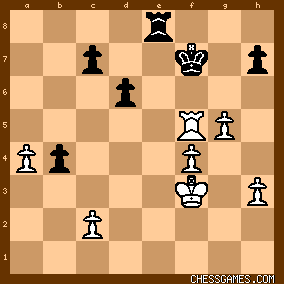May-01-09
 | | keypusher: Here are some of Lasker's notes in the tournament book about this interesting game. <After 10....c5>
The situation is rather difficult for Black. The move made is not the best. 10....Ng4, as played by E. Cohen in Lasker vs E Cohn, 1909 in the 17th round, seems more to the point. Then if 11. Bxe7 Qxe7 12. f4, Black plays ...f5 with the continuation 13. Nxf5 Bxf5 14. exf5 Qe3+; or if 13. Rae1 fxe4 14. Nxe4 Qh4 15. h3 Nf6; and if 13. h3 fxe4 14. Nxe4 Nf6 15. Rae1 Nxe4 16. Rxe4 Qf7, with an even game. <After 11. Nf5>
A forcible move. The opening of the K file is to White's advantage. Moreover, the pawn at f4 is very useful. <After 18. Ne4>
An excellent move. Its purpose is to remove the Black Knight, which is a strong defensive piece and blocks the f-pawn. White now has every advantage: the open file, the freer field, and, besides, safe Pawns, whilst Black's a-pawn is in jeopardy. <After 19....Kf8>
Likewise after 19....Rxe4 20. Qxe4 Rd8 21. Qb7 or 20....d5 21. Qe7 Qxe7 22. Rxe7 Rc8 23. Rd7, Black would not lie on a bed of roses. 
click for larger view<After 20. f6>
In conjunction with his next move, a pretty combination, which came near winning the game, and which should probably have won by force. <After 26. Qg5+>
White thinks he can win the end game because Black has a doubled pawn. But he might have waited, and first deprived Black's doubled pawn of its mobility by 26. b3. This he might have followed with 26....Rf7 27. f4 and advance of the king and g2-g4, with good prospects of winning. <After 30. Kf1>
White can no longer prevent ....c5-c4. If 30. b3 Ke6 31. Kf1 Kd5 32. Ke2 c4 just in time. <In the tournament book, Lasker gives the time used by the players in each game. In this encounter Bernstein's time used was one hour fifteen minutes and Lasker's was exactly twice as much!> |
|
| May-07-09 | | Calli: Bernstein admitted that he played too fast. He recommended 26.Qe3 as decisive. Disappointed, he refused Lasker's draw offer in the ending. Later, Lasker told him that it was the first time in his life he had offered a draw and he would never do it again! |
|
Feb-08-10
 | | keypusher: <Calli>
<Bernstein admitted that he played too fast. He recommended 26.Qe3 as decisive.> 26.Qe3 is certainly stronger than trading off the remaining pieces as in the game, but is not a clear win according to Shredder. Black has the interesting try 26...Kf7 27.Rh6 Kg8!, and it's hard for White to find a way to drive his advantage home, e.g. 28.Rh5 Rf6 and, say, 29.Qb3+ Kg7 30.Qb7 Qe7 is not very promising. Incidentally, Soltis does not agree with Lasker's negative assessment of 10...c5. In his notes to Lasker vs Salwe, 1909 he writes that 12...Re8 or 12...Rb8 would have given Black good play. |
|
| Feb-09-10 | | ughaibu: I see the Salwe game was played first. |
|
| Apr-18-11 | | Rama: It is interesting to compare this ending to E Cohn vs Rubinstein, 1909 played the same round by the two main contenders. |
|
| Jul-28-14 | | Ulhumbrus: <Calli: Bernstein admitted that he played too fast. He recommended 26.Qe3 as decisive> After 26 Qe3 Black cannot keep White's rook out of both of the squares e7 and e8. Suppose that Black covers e7 and allows Re8. On 26...Rf7 27 Re8+ Rf8 White can play 28 Re7 attacking Black's queen and so giving Black no time for 28...Rf7 |
|
Jul-28-14
 | | tamar: Fascinating position after 25...Rf8.
26 Qe3 and 26 Re3 both give White great pressure, but Lasker's suggestion of the slower 26 b3 might be best, exploiting Black's lack of constructive moves. <White thinks he can win the end game because Black has a doubled pawn. But he might have waited, and first deprived Black's doubled pawn of its mobility by 26. b3. This he might have followed with 26....Rf7 27. f4 and advance of the king and g2-g4, with good prospects of winning.> 26 b3 a5 27 f4 Rf7 28 Re3 Qd8 29 Kh2 (as Lasker predicted, Black has no counter for the advance of the g pawn)
Kh8 30 g4 Qf8 (a rook ending is the best Black can do, but it is lost because it is Black with the weak pawns.) 31 Qxf8+ Rxf8 32 Kg3 Rf7 33 Re8+ Kg7 34 a4 Kf6 35 g5+ Kg6 36 Kf3 Rd7 37 Rg8+ Kf7 38 Ra8 Re7 39 Rxa5 Re8 40 b4! cxb4 41 Rxf5+ 
click for larger view+2.19/29 Komodo 5 64 bit |
|
| Jul-29-14 | | Ulhumbrus: <tamar: Fascinating position after 25...Rf8. 26 Qe3 and 26 Re3 both give White great pressure, but Lasker's suggestion of the slower 26 b3 might be best, exploiting Black's lack of constructive moves. <White thinks he can win the end game because Black has a doubled pawn. But he might have waited, and first deprived Black's doubled pawn of its mobility by 26. b3. This he might have followed with 26....Rf7 27. f4 and advance of the king and g2-g4, with good prospects of winning.> > A brilliant idea! If White can make no further progress with his heavy pieces, instead of trying to make further progress with his heavy pieces White takes advantage of the fact that Black can do nothing constructive and makes progress elsewhere with his king and pawns There is one thing: In order for this to be justified White has indeed to possess no quicker way to make progress after eg 26 Qe3. One question is whether Lasker had considered 26 Qe3 and found a defence for Black. |
|
Jul-29-14
 | | tamar: I can imagine Ossip Bernstein's discomfiture after the handshake having Lasker tell him he had a won game. <One question is whether Lasker had considered 26 Qe3 and found a defence for Black.> He doesn't say. But as you reason, if there is no immediate win by attacking with the major pieces, why move them? The only possible defense after 26 Qe3 is 26...Kf7 and Lasker will have looked at that over the board. Then 27 Rh6 Kg8 28 Rh5 Rf7 White should win, as he can eventually gang up on the f pawn, or switch to the a pawn when there is no counterplay. Lasker may have preferred this situation with Black, bad as it is, as it leaves open a few possibilities of sacking a pawn to get activity. |
|
| Jul-29-14 | | Ulhumbrus: <tamar:... But as you reason, if there is no immediate win by attacking with the major pieces, why move them?> Flattering and modest, but I will point out that you were the one to indicate <...Black's lack of constructive moves.> |
|
Jul-29-14
 | | tamar: <Ulhumbrus> For that matter, the whole notion is cribbed from Lasker's comment that White "might have waited". At first I thought Lasker was being a lazy annotator, but the computers confirm that 26 Re3 and 26 b3 are fully equal as winning concepts, while 26 Qe3 requires more maneuverings to prove. |
|
|
|
|





































